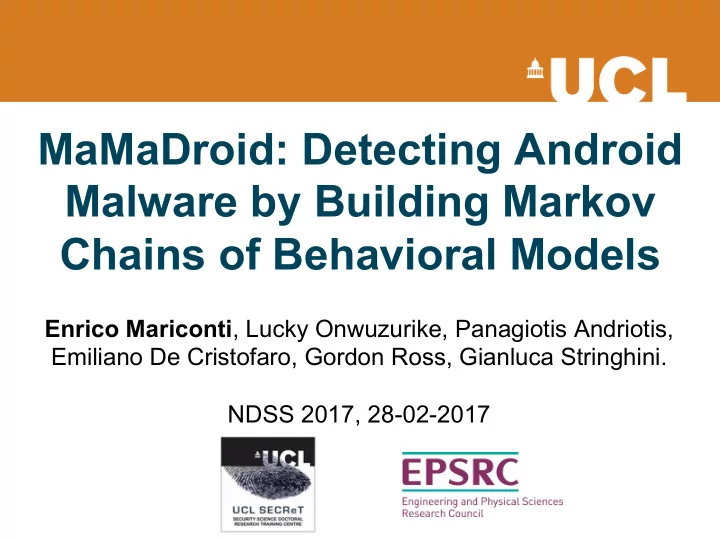

MaMaDroid: Detecting Android Malware by Building Markov Chains of Behavioral Models Enrico Mariconti , Lucky Onwuzurike, Panagiotis Andriotis, Emiliano De Cristofaro, Gordon Ross, Gianluca Stringhini. NDSS 2017, 28-02-2017
Motivation: Android & Malware • Android market share is growing – In 2016, 85% of smartphone sales • At the same pace the interest by cybercriminals is growing – Bypassing two-factor authentication – Stealing sensitive information, etc. 2
Motivations: Current Defenses • Can’t use complex on-device operations – Limited battery and memory resources • Google’s centralized analysis – Previous work shown a few incidents – Users buy apps from third party markets • Lots of research in the field! However – Permission-based models prone to false positive – Relying on API calls frequently used by malware needs constant, costly retraining 3
Motivations: Our Idea Intuition: malware uses calls for different actions and in different order than benign apps – E.g. android.media.MediaRecorder used by any app with permission to record audio – Only using it after calls to getRunningTasks(), which allows to record conversations, may suggest maliciousness Rely on the sequence of abstracted calls 1. Sequence captures the behavioral model 2. Abstraction provides resilience to API changes 4
MaMaDroid 5
Overview 6
Call Graph Extraction • Based on static analysis – Given an apk, extract call graphs • Tools – Soot (Java optimization and analysis framework) – FlowDroid 7
Call Graph 8
Overview 9
Sequence Extraction • Soot gives the call graph from which we extract the sequence of functions that are potentially called by the program, but … • When running example multiple times … – Execute() may be followed by different calls, e.g., getShell() only in try or getShell() + getMessage() in catch 10
Sequence Extraction • We proceed as follows: 1. Identify set of entry nodes 2. Enumerate paths 3. Output set of all paths as the sequences of API calls • But we said we were using abstracted calls! 11
Abstraction Package android.text.style.CharacterStyle: void <init>() Package Family android.os.Bundle: void <init()> Family Package java.lang.thowable: String getMessage() Family 12
Abstraction • Packages – Using the list of 243 packages (as of API level 24) + 95 from the Google API – Packages defined by developers à “self-defined” – If we can’t tell what its class implements à “obfuscated” • Families – 9 families: android, google, java, javax, xml, apache, junit, json, dom – Plus self-defined and obfuscated 13
Example 14
Example 15
Overview 16
Markov Chain • Memoryless models – Probability of transition from a state to another only depends on the current state • Represented as a set of nodes – Each corresponding to a different state, and a set of edges labeled with the probability of transition. • Sum of all probabilities associated to all edges from any node is exactly 1 17
Building the Markov Chains Nodes / States Sequence of abstracted API Features set calls Edges / Transition Probabilities 18
Example 0.5 Self-defined 0.25 0.25 Java Android 19
Feature Extraction • For each app: – Feature vector = probabilities of transition from one state to another in the Markov chain – With families, 11 possible states à 121 possible transitions in each chain – With packages, 340 states à 115,600 transitions 20
Overview 21
Classification • Build a classifier using the extracted features – Each app labeled as benign or malware • We tested our idea using: – Random Forests – 1-NN, 3-NN – SVM • SVM was less efficient than the other systems 22
Dataset 23
Datasets # # Samples # Samples Category Name Date Range Samples (API Calls) (Call Graph) OldBenign Apr 13 – Nov 13 5,879 5,837 5,572 Benign NewBenign Mar 16 – Mar 16 2,568 2,565 2,465 Total Benign 8,447 8,402 8,037 Drebin Oct 10 – Aug 12 5,560 5,546 5,538 2013 Jan 13 – Jun 13 6,228 6,146 6,123 Malicious 2014 Jun 13 – Mar 14 15,417 14,866 14,827 2015 Jan 15 – Jun 15 5,314 5,161 4,725 2016 Jan 16 – May 16 2,974 2,802 2,657 Total Malicious 35,493 34,521 33,870 24
How many API calls? 25
Evaluation 26
Evaluation • Accuracy of classification on benign and malicious samples developed around the same time • Robustness to the evolution of malware as well as of the Android framework (using older datasets for training and newer ones for testing and vice-versa) 27
Same Year 28
Training on older samples Families abstraction � 29
Training on newer samples Families abstraction � 30
MaMaDroid Vs DroidAPIMiner DroidAPIMiner is the previous work operating detection of malware samples from benign ones based on sequences of API calls. Tests DroidAPIMiner MaMaDroid Same 0.56 0.96 Year Older samples 0.42 0.68 Training Newer samples 0.50 0.96 Training 31
Discussion and Limitations 32
Case Studies (2016/newbenign) • False Positives (164 samples) – Most of them “dangerous permissions” – E.g., SMS permissions not clear why requested • False Negatives (114 samples) – Actually not classified as malware by VirusTotal, might be legitimate – Most of them adware 33
Evasion • Repackaging benign apps – Difficult to embed malicious code while keeping similar Markov chain, viceversa is also hard • Imitating Markov chains – Likely ineffective • Obfuscation/Mangling – Still captured by the [obfuscated] abstraction • More in the paper … 34
Limitations • Classification is memory hungry • Soot is buggy, we lose ~4% of the samples • Limits of static analysis only methods 35
Future Work • Further investigate resilience to evasion – Focus on repackaged malicious apps – Injection of API calls to mess with Markov chains • Enhancements – Fine-grained abstractions (e.g., class) – Seed with dynamic analysis • Releasing – MaMaDroid’s python code – The list of used samples and their hashes – Parsed dataset 36
Conclusions • We created MaMaDroid, a system for android malware detection • Static analysis only, based on Markov Chain modeling of sequences of API calls • Up to 0.99 F-measure in tests, resilient to changes over time Enrico Mariconti � Thanks for listening 37
Recommend
More recommend